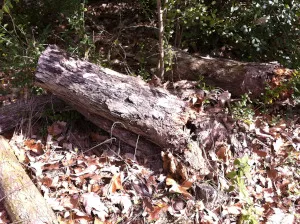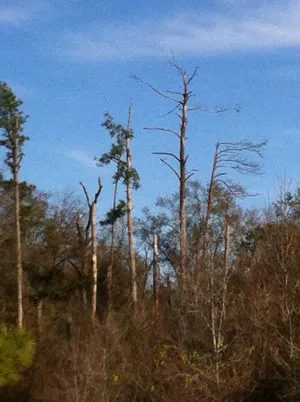The saying, “You can’t see the forest for the trees” is appropriate when talking about tree identification. Without some knowledge of forest ecology you miss the beauty and wonder of why the trees you identify exist.
The first principle to remember is that a tree does not exist by itself. Each tree is part of a forest, a community, an association of a variety of trees, herbaceous plants, grasses, shrubs, soils, animals, waters, and terrains that all fit together in a landscape. Each of these community parts interact and has a relationship with the others. Thus the word ecology is defined as the relationship of organisms, with themselves, other organisms, and the non-living environment (abiotic).
Forests exist in many forms, from 20 acre woodlots to the 20 million acres of forests in Texas. For our purposes, we will look at individual trees in a landscape setting. Landscapes are usually several tens of thousands to millions of acres in size and are defined by the lay of the land and its hills, mountains, rocks, soils, valleys, rivers, and streams.
When looking at trees and their ecology, the most important concept to remember is the role that disturbance plays in perpetuating a forest and its trees.
At one time it was thought that forests evolved to a climax or self-perpetuating state, where a few dominant (tallest or largest) trees could successfully reproduce themselves decade after decade and century after century.
Today we know this is too simple of an explanation for why and where we find forests and trees. Scientists now believe that due to hurricanes, tornadoes, droughts, windstorms, ice storms, hail storms, floods, fires, soil change, insects, diseases, lightning, and other forms of disturbance, an ever-changing group of trees is created to form a forest.
This constantly changing group of trees is called a shifting mosaic. There are different trees living in different places; different ages of each tree species (seedling, sapling, pole, mature, and old growth); and different layers or structure of vegetation (grass, herbaceous, shrub, understory, midstory, and overstory); that create conditions so that other plants and animals have a place to live (habitat).
Each tree has its own job to do (niche) which helps make the forest a whole of interrelationships and not simply a group of individuals. For instance, Flowering Dogwood brings calcium to the surface by its roots (storing the calcium in its leaves which fall each autumn) and provides this essential nutrient to other trees or plants that need it for their growth (Loblolly Pine).
Dead or sick trees also play a role in these interrelationships. For example, when a large tree loses a limb or is blown over this creates a hole or gap in the canopy above (where the tree tops or crowns have come together) which allows tree seedlings, grass, herbaceous plants, and shrubs to compete and grow into the space in a race for sunlight.
A downed tree (coarse woody debris) provides a seedbed for seedlings (nursery tree) as well as nutrient and organic enrichment of the soil so that other trees can grow. Downed trees provide hiding places for a myriad of animal life; provide places for fungi to grow and turn the cellulose of the tree into rich fertilizer; and act as natural check dams to prevent soil erosion. Downed trees create conditions that ensure that moisture is retained for longer periods of time.

A standing dead tree (snag) provides a home for woodpeckers, bats, squirrels, and other animals. A sick tree, which has fungal rot that leaves a hollow base or space in the trunk or a branch provides a den or cavity for raccoons, opossums, birds, snakes, frogs, other animals, and in the case of large trees, like Black Gum, Water Tupelo, and Bald Cypress, shelter for black bear.

Finally, tolerance must be discussed. Tolerance refers to how much shade a tree can withstand. This differs depending on how old a tree is. When a tree has slowed or stopped growing due to a reduction in sunlight it is said to be suppressed or to have been overtopped by other trees that shade it.
Some trees, like Southern Magnolia, can exist in heavy shade for decades. Other trees, like southern pines (Longleaf, Shortleaf, and Loblolly Pines), need a great deal of sunlight or they will die. When shaded, many trees develop larger leaves to catch as much of the filtered sunlight as possible to increase their chances of survival.
Without the forest there would be few trees. When trees grow together as a forest they protect each other from blowdowns and drying of the forest better than when they grow alone. Individual trees need a forest for mutual protection and the forest needs all different kinds of trees to make it a forest.